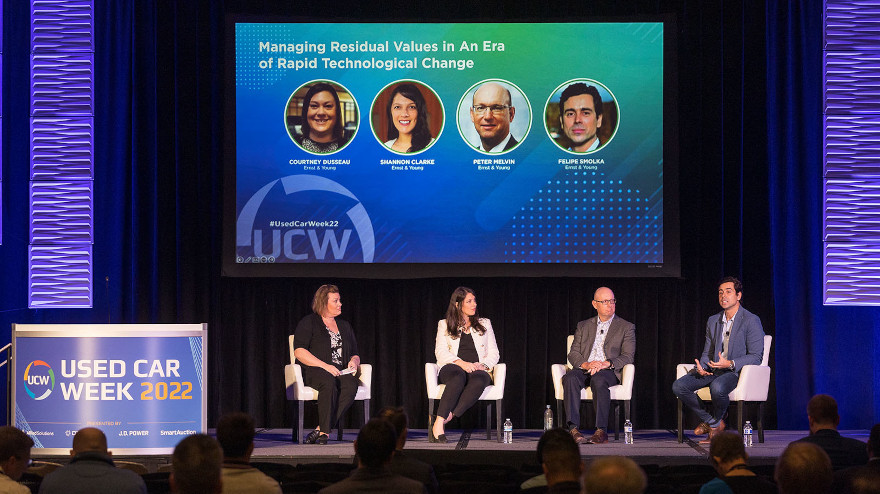EV residual value determination becomes more important as sales set to take off

The “Managing Residual Values in An Era of Rapid Technological Change” panel at Used Car Week earlier this month in San Diego. Photo by Jonathan Fredin.
As electric vehicles sales rise, so will the number of used EVs on the market. Two panels at Used Car Week earlier this month addressed the importance of determining EV residual values and how subscription services will play a role in EV adoption.
“The time is now for EVs,” said EY partner and eMobility automotive leader Felipe Smolka on the “Managing Residual Values in An Era of Rapid Technological Change” panel.
By 2035, some 85 million EVs will be on the road in the United States and Canada, estimates consultancy EY.
Access to data is crucial to determine the residual value of those EVs, said panelist Shannon Clarke, EY's mobility leader in Americas captive, equipment and automotive finance practice.
Knowing how a battery was used — including how it was driven and what kind of charging was used — will impact the battery health, she said. Battery health will need to be tracked and the right “control points” will need to be created to protect residual value.
For fleets, “charging strategy can make a big impact,” said Clarke. “Decisions made now impact future value.”
How to address battery second life is an area of growing importance, said Smolka. If a battery is depleted by more than 20%, it is at the end of its life as an EV battery.
Questions then include: Is the battery ready to salvage? Can its life be extended? Can it be repurposed for stationary storage and if so, for solar or for wind energy? he said. As well, the market for recycled battery materials is “booming,” said Smolka.
Automakers are already considering how strategic it is to own an EV asset long-term. General Motors in October launched the GM Energy division to address EV ecosystem integration, he pointed out.
The way to define the total value of an EV battery has thus become not so clear, said Smolka.
“The battery may have 16 to 20 years as an end-of-life storage system. So, it would have a 25-year economic life. That is a very different time frame,” he said.
One reason EVs sales have lagged in the US is the high cost. Subscription services are a way to overcome the hurdle of the upfront cost of an EV, said Allen Bryant, co-founder and partner at Knightsgate Ventures, and a panelist on the “EVs, Subscription Models: Manufacturing Used Cars” panel.
“Mobility as a Service — MaaS — is a trend,” he said. “The pain point for EVs is upfront cost of ownership. The subscription model alleviates the upfront cost.”
US consumers have yet to become enthusiastic about the subscription model. Holman Strategic Ventures discovered this when, in 2017, it formed the Flexdrive vehicle subscription service joint venture with Cox Automotive.
Flexdrive was unable to attract enough subscribers to make the JV viable, said panelist Bill Cariss, president and CEO of Holman Strategic Ventures.
“Customers love the ability to get in and out of a car on a regular basis,” he said. “They love the model but the unit economics matter. We weren’t to get to a price point” where it made sense economically.
Lyft in 2020 acquired Flexdrive. Holman Enterprises leases the cars to Flexdrive and Lyft, said Cariss. “It is a competitive advantage” for Lyft, he said.
Europe has proved that with the right incentives, subscription services can be very popular, said Cariss.
“The subscription case for EVs is much stronger” there, he said. “Because of the tax law, the subscription model is taking off in Europe.”
Another factor that favors the EV subscription model in Europe is that five to six times more EVs have been sold there than in the US, said Bryant.
“The price point of EVs is lower there. There is a lower barrier to entry, so the subscription model is taking off.”
Both panelists predicted that the environment in the US was becoming ripe for EV subscription services.
The federal government is offering thousands of dollars in tax rebates for an EV purchase, said Cariss.
“We live off total cost of ownership. With a $4,000 rebate right away, the depreciation curve flattens. It allows for more flexibility when running a fleet portfolio,” he said.
There is a “perfect storm” of positive factors, including billions of dollars of investment into the EV ecosystem, said Bryant.
“All the pieces are coming together now,” he said. “The range issue is getting solved while the price point is coming down.”
At the close of the session, moderator John Possumato, founder of DriveItAway Inc., asked both panelists if they had any advice or predictions for startups seeking investment in the wake of the tech firm crash.
“Unit economics matter,” said Cariss. The days of “hockey stick growth curves” are over, he said.
Gross margins matter now, he said, and “solid businesses with solid business plans.”
The days of growth at all costs are truly over, Bryant said. “There must be a line of sight to profitability.”
He added: “if there is no unit economics there will be no investment.”

 View The Latest Edition
View The Latest Edition

